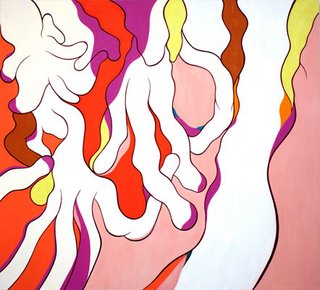My second exhibition was a real
emergence in terms of defining a specific aesthetic. It was an exhibition of
large abstract paintings inspired by my readings in the history of the New York
School, and how that generation continues to create a consensus for the
motivation of young painters everywhere.
Having been raised on Conceptualism, I knew that it might be considered a step backward in terms of the formal language and approach to the notion of abstraction, but here I was touching the very artistic passion for abstraction within my own generation, and it was compelling to say the least.
This exhibition took shape over
the course of eight months. I am not sure whose work specifically began the
conception out of which it sprang, at least three or four artists contributed
to my developing aesthetic. I cannot list them in any specific order. I would
rather talk about how the art historical perspective I had aided me in
recognizing the inherent value of work by contemporary abstract artists. I have
since that time organized at least five other exhibitions about painterly abstraction
and the cultural imprint it maintains.
As far as my recollection stands,
I can say that I met or heard about the majority of these painters from one
another, and met them at various gallery receptions including those at Pierogi
2000, where I had visited upon the gallery's inaugural exhibition, which was
for Robert Smithson, a Conceptual artist considered highly by my father and
others of our shared milieu in the gallery world. Despite the Conceptual
leanings of this specific exhibition, the gallery by and large represented the
creative talents of the local Williamsburg community, which was heavily
expressive of painterly and otherwise pictorial elements. The gallery's
openings were special. Located only two blocks from the Bedford Avenue subway
stop, they served Polish Vodka and Pierogis to visitors.
Karen Arm was one of those I met here. When I visited her Tribeca studio, I was confronted by a series of large abstract paintings that alternated between scenes of the galaxy and depictions of smoke rising and intertwining. An exploration into the expression of mystery had led her to depict the breadth and structure of the cosmos and alternately the most effervescent of elemental exchanges.
)_2011_18x15.jpg)






